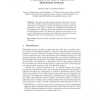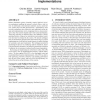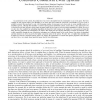CORR
2011
Springer
14 years 1 months ago
2011
Springer
Self-stabilization is a versatile approach to fault-tolerance since it permits a distributed system to recover from any transient fault that arbitrarily corrupts the contents of a...
IC3
2009
14 years 4 months ago
2009
Abstract. This paper presents liveness properties that need to be preserved by Event-B models of distributed systems. Event-B is a formal technique for development of models of dis...
CF
2009
ACM
14 years 4 months ago
2009
ACM
Emulation sits between simulation and experimentation to complete the set of tools available for software designers to evaluate their software and predict behavior under condition...
SIGSOFT
2010
ACM
14 years 4 months ago
2010
ACM
Robust distributed systems commonly employ high-level recovery mechanisms enabling the system to recover from a wide variety of problematic environmental conditions such as node f...
SASO
2010
IEEE
14 years 4 months ago
2010
IEEE
Many large-scale distributed systems have been built with great complexity to run Internet services. Due to the heterogeneity and dynamics of complex systems, it is very difficult ...
PDPTA
2010
14 years 4 months ago
2010
There exist distributed scenarios in which the need for dynamism, mobility, and adaptivity, has to be addressed with highly dynamical approaches. These scenarios present different ...
IPPS
2010
IEEE
14 years 4 months ago
2010
IEEE
This paper investigates scheduling loosely coupled task-bundles in highly heterogeneous distributed systems. Two allocation quality metrics are used in pay-per-service distributed ...
IPAW
2010
14 years 4 months ago
2010
Abstract. The heterogeneous and unreliable nature of distributed systems has created a distinct need for the inclusion of provenance within their design to allow for error correcti...
DEBS
2010
ACM
14 years 5 months ago
2010
ACM
Providing reliable fault-tolerant sensors is a challenge for distributed systems. The demonstration setup combines three sensors and allows to inject different faults that are rel...
SOCA
2010
IEEE
14 years 5 months ago
2010
IEEE
In asynchronous event systems, the production of an event is decoupled from its consumption via an event queue. The loose coupling of such systems allows great flexibility as to ...



